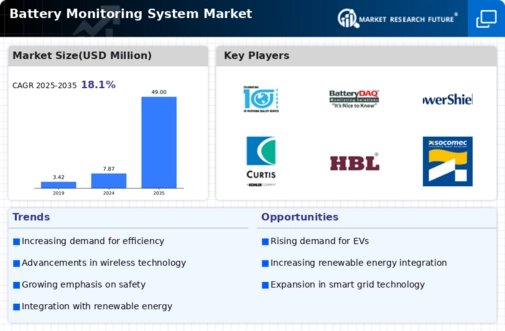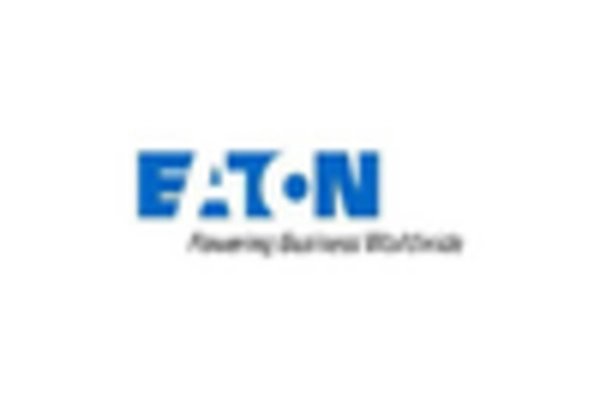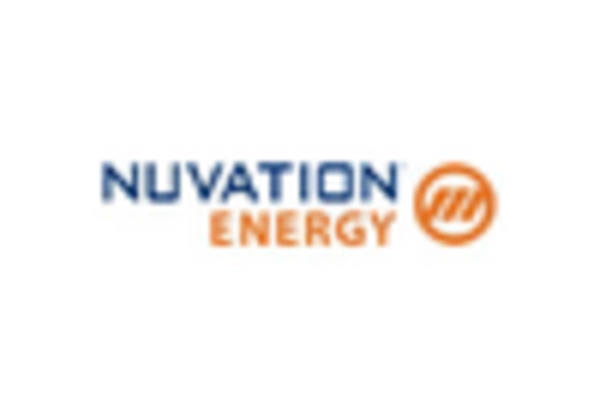Market Growth Projections
The Global Battery Monitoring System Market Industry is poised for substantial growth, with projections indicating a market value of 7.87 USD Billion in 2024 and an anticipated increase to 49.0 USD Billion by 2035. This growth trajectory suggests a compound annual growth rate (CAGR) of 18.1% from 2025 to 2035. Such figures underscore the escalating demand for battery monitoring solutions across various applications, including electric vehicles, renewable energy storage, and industrial uses. The market's expansion reflects the increasing importance of battery management in ensuring efficiency and safety.
Growth of Electric Vehicles
The Global Battery Monitoring System Market Industry is significantly influenced by the rapid growth of the electric vehicle (EV) sector. With the global electric vehicle market projected to reach 7.87 USD Billion in 2024, the demand for efficient battery management solutions is paramount. Battery monitoring systems play a vital role in enhancing the safety, efficiency, and lifespan of EV batteries. As governments worldwide implement stricter emissions regulations, the shift towards electric mobility is likely to accelerate, further propelling the need for advanced battery monitoring technologies.
Regulatory Support and Incentives
Regulatory support and incentives play a crucial role in shaping the Global Battery Monitoring System Market Industry. Governments worldwide are implementing policies to promote the adoption of battery monitoring technologies, particularly in the renewable energy and electric vehicle sectors. For example, various countries offer tax credits and subsidies for energy storage systems, which encourages investment in battery monitoring solutions. This supportive regulatory environment is likely to foster innovation and growth within the market, aligning with the projected CAGR of 18.1% for 2025-2035.
Rising Demand for Renewable Energy
The Global Battery Monitoring System Market Industry is experiencing a surge in demand due to the increasing adoption of renewable energy sources. As countries strive to meet sustainability goals, the integration of battery storage systems becomes crucial for managing energy supply and demand. For instance, the International Renewable Energy Agency indicates that the global renewable energy capacity is expected to reach 4,000 GW by 2024. This transition necessitates advanced battery monitoring systems to ensure optimal performance and longevity of energy storage solutions, thereby driving market growth.
Increasing Focus on Energy Storage Solutions
The Global Battery Monitoring System Market Industry is benefiting from the increasing focus on energy storage solutions across various sectors. As industries and utilities seek to enhance grid stability and reliability, the demand for battery storage systems is on the rise. According to the U.S. Department of Energy, energy storage capacity is expected to grow significantly in the coming years. This growth necessitates the implementation of advanced battery monitoring systems to optimize performance and ensure safety, thereby driving market expansion.
Technological Advancements in Battery Technologies
Technological advancements in battery technologies are a key driver of the Global Battery Monitoring System Market Industry. Innovations such as solid-state batteries and lithium-sulfur batteries promise higher energy densities and improved safety. These advancements necessitate sophisticated monitoring systems to manage battery health and performance effectively. As manufacturers invest in research and development, the market is expected to witness a shift towards more efficient and reliable battery monitoring solutions, which could lead to a projected market value of 49.0 USD Billion by 2035.

















Leave a Comment